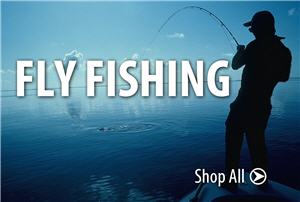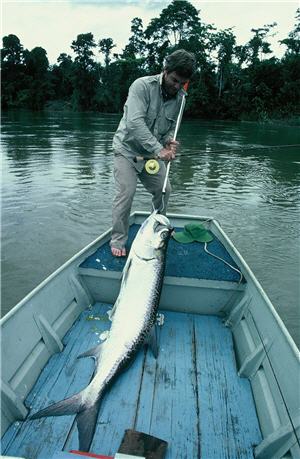
If you like relaxing, laid-back fishing, here’s a warning: don’t go after tarpon with a fly rod. But if you like your sport physical and demanding, this is it!
With a determined attitude and knowledge of the right fish-fighting skills required you can meet the challenge of taking a tarpon on a fly. And when you succeed, you’ll experience one of the sweetest rewards angling has to offer as you twist the hook free and watch this silver brawler surge back into the depths, none the worse for wear.
Practice Casting a Heavy Weight Fly Outfit
Before even trying to tackle a tarpon on a fly, practice casting with heavy gear such as an 11-13 weight fly fishing outfit and stiff fly rod. You need to be able to cast at least 50 feet, preferably into a moderate wind.
![]() Tip: Practice in your back yard, a swimming pool, the local pond—anywhere. You need to get your timing and technique down before even venturing out into the waters of Costa Rica, the Florida Keys, or wherever you plan to challenge this hulking silver fish.
Tip: Practice in your back yard, a swimming pool, the local pond—anywhere. You need to get your timing and technique down before even venturing out into the waters of Costa Rica, the Florida Keys, or wherever you plan to challenge this hulking silver fish.
Rely on Your Fishing Guide
Unless you’re a veteran flats angler, you’ll likely be fishing with a guide who works virtually every day on the water studying the fish and knowing where to find them on every tide phase. Follow his or her advice. Don’t try to be a know-it-all and make suggestions. They won’t appreciate it, and you don’t know one-tenth of what they do about tarpon.
 |
| Author admires a tarpon he caught on a streamer fly off of Costa Rica near the Nicaragua border. |
![]() Tip: Learn to follow directions based on the hands of a clock. The guide will say “tarpon, 3 o’clock, 70 feet. He will mean 90 degrees to your right and 70 feet out, just like a timepiece hand would be positioned. Start working line out to cast in that direction and about that distance immediately. Try to spot the fish, but if you can’t, drop it as close as possible to the target location the guide describes. Then strip it as fast or slow as your tutor suggests.
Tip: Learn to follow directions based on the hands of a clock. The guide will say “tarpon, 3 o’clock, 70 feet. He will mean 90 degrees to your right and 70 feet out, just like a timepiece hand would be positioned. Start working line out to cast in that direction and about that distance immediately. Try to spot the fish, but if you can’t, drop it as close as possible to the target location the guide describes. Then strip it as fast or slow as your tutor suggests.
![]() Tip: A hat with a brim and polarizing sunglasses are vital to help you spot the fish through the glare on the water’s surface.
Tip: A hat with a brim and polarizing sunglasses are vital to help you spot the fish through the glare on the water’s surface.
A Psychological Approach to Land the Tarpon
Once you hook up, you want to land the tarpon with a quick victory. This serves two purposes. It increases the fish’s survival odds and produces the least wear and tear on your body so you can have the strength to battle another one.
Fight the fish aggressively, yet intelligently. Sheer muscle won’t do the trick. You’ll just break the leader. Instead, you need to apply the maximum force the tippet will bear with a fighting strategy that constantly counters what the tarpon wants to do.
![]() Tip: Confuse the fish and you break the fish’s will.
Tip: Confuse the fish and you break the fish’s will.
How to Have Successful Tarpon Encounters
Veteran Florida Keys guide Mike Vaughn is the past president of the Marathon Guides Association and past secretary of the Florida Keys Guides Association. He has guided countless anglers to successful tarpon encounters after having grown up in Pennsylvania and cut his teeth on trout and bass before moving to Florida.
“You need to strike hard, but not too quickly or you might pull the fly out the tarpon’s mouth. Hesitate 1-2 seconds after you see him eat the fly.”
“After the fish feels tight on the line, set up as if you were double-hauling, using a series of jabs. Pull back with the rod hand, down and forward with the line in the other hand. Drive the hook into the fish’s mouth, which is bony and hard to penetrate.”
Odds are good you will have extra line on the deck when you hook a fish. The first thing you must do is clear that line. The tarpon will likely help by streaking off on a searing run. Hold the rod high so the line can feed smoothly through the guides and you can get the fish back on the reel.
At this point some fish will race towards the horizon while others may stay close and battle it out deep. The majority, though, will react yet a third way. They’ll explode violently on the surface with wild leaps. That’s the next important phase of the battle.
“Bow to him with the rod and your body when he jumps or he’ll snap a 15 pound tippet like thread,” says Vaughn. “As soon as he starts to come out of the water, lean forward, bend at the waist and give all the controlled slack you can. When he falls back in, immediately come up tight again.”
The only way to tire a tarpon is pumping. When the fish streaks away, let him have free reign. When he eases up, apply pressure.
![]() Tip: Always pull the opposite way from the direction the fish wants to go. Keep him off-balance.
Tip: Always pull the opposite way from the direction the fish wants to go. Keep him off-balance.
Tarpon Fishing Mistakes to Avoid
If you lighten the pressure, the fish will rest and the battle will be prolonged. That’s not only tiring for you, it wears the fish out more, reducing chances for releasing the tarpon in a healthy condition.
Another thing to avoid is allowing the quarry to gulp air. If he does that, his stamina increases and the battle drags on.
![]() Tip: Put your rod tip low, even in the water if he tries this. Pull him down when he tries to get air. If he does gulp oxygen, pressure him and make him burp it out.
Tip: Put your rod tip low, even in the water if he tries this. Pull him down when he tries to get air. If he does gulp oxygen, pressure him and make him burp it out.
Try to force the fish to work continuously. Don’t let him rest. Confuse him by turning him one way when he tries to go another. Keep him from gulping air and avoid any slack line except during jumps.
Follow these words of advice and you will soon accomplish one of the greatest feats in angling—landing a tarpon on a fly.
- 4757 views

